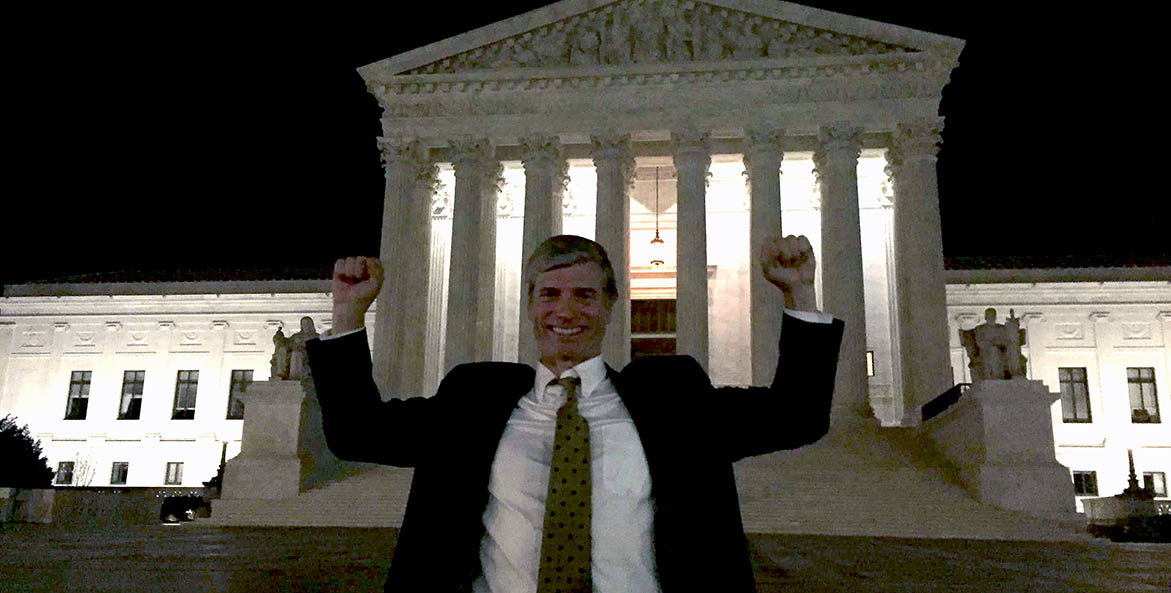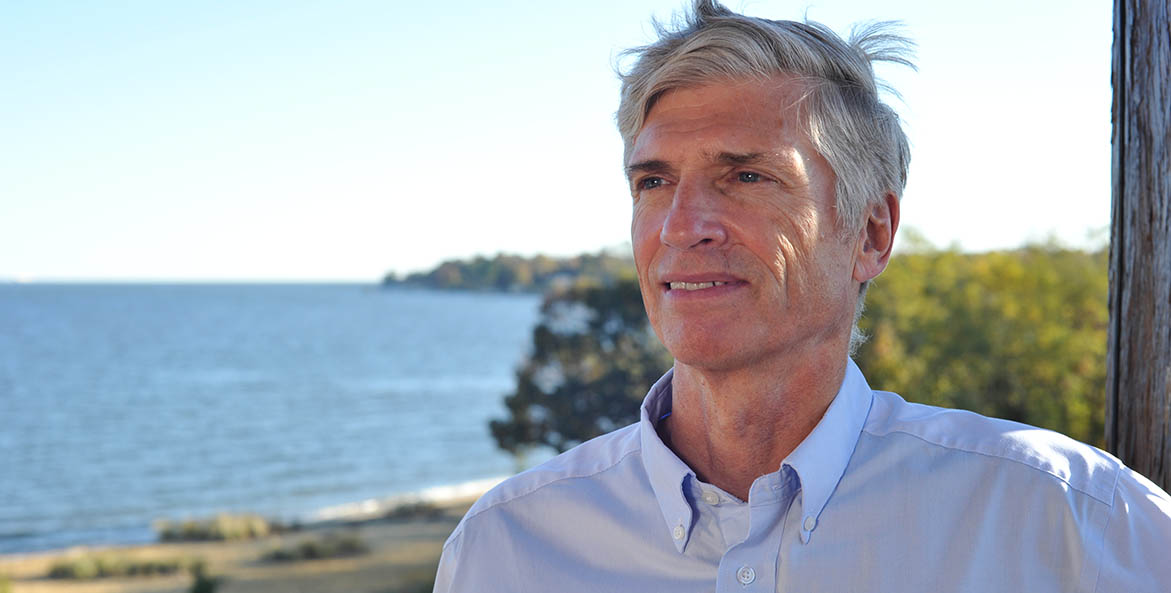Roughly seven years ago, on a late Monday night following CBF's bi-annual D.C. on the Half Shell gala, a small group of colleagues gathered on the Supreme Court steps. We had felt a pull to come to the Nation's highest court, in an almost unspoken way following the event—fueled some by too much champagne, but mostly by a downright giddiness following a legal victory led by the one and only Jon Mueller.
Earlier that day, the U.S. Supreme Court had denied the request of the American Farm Bureau Federation and its allies to take up their case challenging the legality of the Chesapeake Clean Water Blueprint. For five years we had fought tirelessly in the courts—Jon as our leader—to defend the commonsense solution to reducing pollution. Hours after the Supreme Court announced its refusal to take up the case, in the thick of that late Monday night, we celebrated the long-fought win on those steps. It was an historic victory for the Bay, its thousands of rivers and streams, and the more than 18 million people that call this region home. And at the center of it was Jon.

Jon Mueller on the steps of the U.S. Supreme Court building shortly after the ruling in American Farm Bureau Federation et al v. EPA upholding EPA's authority to issue the Bay Total Maximum Daily Load (TMDL) under the federal Clean Water Act.
Emmy Nicklin/CBF Staff
In the 19 years Jon has been with CBF, his successes—including that of the Fowler v. EPA case that resulted in the very Chesapeake Clean Water Blueprint itself—are innumerable. But perhaps his greatest CBF achievement is that of building a robust, talented team of "superstars" as Jon says to stand up for clean water and the oft-forgotten communities that depend on it. "Jon has always pushed us to be better advocates by telling compelling stories," says Director of Litigation Paul Smail. "An effective lawyer must always have command of the applicable law and universe of facts in every matter, but often that is not enough, particularly in environmental law cases when one challenges corporations and the government. Every success we've had as a team has been the result of moving a court to find in our clients' favor by connecting the legal issues with their impact on people and the resource that is Chesapeake Bay. For me, this will remain Jon's legacy."
On the eve of his departure from CBF, we took a moment to sit down with Jon and reflect on his work and the legacy he leaves behind.
What drew you to the Bay those many years ago and kept you here at CBF for nearly 20 years?
I'd been at the Justice Department for 17 years, and I was probably at the top of the management ladder. I liked litigating, but I didn't like the travel. At DOJ, I was working from North Carolina to Florida to Arizona to California, even Hawaii. At CBF, I could actually handle cases where I was living and was personally connected to.
CBF and the Board gave me tons of opportunity to take on cases that I never would have had the opportunity to do at the Justice Department or even private practice. They essentially said you decide where you want to go. The goals were clear, but it was up to me to figure out how to get there. Our Board recognized the need to augment our education, restoration, and advocacy programs with what, in many ways, is a means of last resort to resolve difficult problems.
We wanted to go after those who violated their permits; we wanted to strengthen government regulation; and we wanted to provide representation to members in communities that typically aren't represented. So, it was pretty wide open. CBF didn't really have an air component at all before I started, and I had just come off of some big coal-fired power plant cases at DOJ. It was important to me to take on cases where we held people accountable for not only harming the environment but harming human health, too.
Your biology background, your deep interest in environmental cases, where does that come from?
You know I'm not from here; I'm from upstate New York and Long Island and then Charlottesville. I did have some Bay connection growing up, but it wasn't really all that close. But what I did have growing up was a pond across the street from my house in Long Island. I was in that pond year-round, catching tadpoles and turtles and frogs and trying to protect the ice in the wintertime because kids would throw stuff on there. We played pond hockey, and you couldn't skate with rocks and beer cans on the ice, so I started cleaning up that pond on my own. I think that's kind of where it started. They actually came down and took a picture of me for the local paper.
But it wasn't until I moved to Richmond to go to law school and work that I started to feel a stronger pull to the Bay. The people in Richmond have a really close connection to the James River and then the Bay. And there's the big Urbanna Oyster Festival and the shad planking and all that kind of stuff. So, I learned a lot more about the Bay from that. And I fished and hunted with friends in Virginia Beach, too.
When you came to CBF in 2004, there was no Litigation Department. You built it from the ground up. Tell me about those early days.
I remember December 2004 sitting at my desk looking out that window thinking, what am I doing here? What do I do? But, once I got my feet wet with a couple of cases like King William and Philip Morris, I started to understand the role that CBF played and the power of CBF as an institution.
The first thing I realized I needed was some kind of paralegal assistance and then eventually I hired additional legal support. [As the new department was forming,] we started looking everywhere...we found a bunch of cases in Pennsylvania, cases out in West Virginia. And we were winning. It was a ton of fun because we could go anywhere and take on some really important cases...More work started to build because the Virginia office, the Maryland office, and others started to see the power of our work. We had a lot of people asking for help. Plus, I started to develop the first case against EPA, the Fowler case [the landmark case that resulted in the Chesapeake Clean Water Blueprint], and that took me about three years to develop and get internal buy-in.
I've always looked at my job at CBF as problem solver. That's why I sat and stared out the window for so long in 2004. I mean there are a ton of problems. How do we solve the problems? And what legal tools, legal theories do we have that could be used to solve them? I think I got laughed at for one of my theories—when we filed the Fowler case. One of the claims of the case was that the Chesapeake Bay Agreement and Section 117(g) of the Clean Water Act make those agreements interstate compacts and therefore they are enforceable just like a federal law. And if you violated the terms of those compacts, you're breaking the law.
Of what are you most proud in all your CBF successes?
Wow, the biggest achievement...there are so many. And to go back to your earlier question Why have I stayed for so long—it has a lot to do with appreciation from the client. My client at DOJ was the United States of America, and nobody was coming up and saying "you saved my backyard" or "thank you for cleaning this up." Here at CBF, the people we represent and the groups we work with recognize the level of effort we are putting in. I still get invitations from the people from the Alliance to Save the Mattaponi for parties they have every year, celebrating that important court decision [that stopped the King William Reservoir].
But I'd say the decision that has stuck with me the most is probably the Buckingham Compressor Station case in Union Hill. It was a classic example of a corporate entity trying to bully their way into people's backyards and saddling them with a polluting source for the rest of their lives. Many of those people moved back to Union Hill to be quiet and come back home and get away from air pollution. And that compressor station and that pipeline was going to alter their lives forever. And they were just so thankful when we won. There was another big party, big fish fry! I brought Taylor [Lilley] out, she had just started at CBF. I think she saw the great sense of achievement and appreciation that you get from helping people. That's the thing that's kept me here.
What's next?
As the Visiting Director at the University of Maryland's Environmental Law Clinic, I'll be working with six students a semester and finding meaningful work they can do over 10 weeks. It'll be a fair amount of identifying communities that don't typically get legal assistance, helping them comment on a proposed development or an air polluting source, submitting comment letters, maybe attending public hearings and speaking. And I'm hoping to move into the next stage of litigation. One of the things we've talked about a lot but haven't been able to pull off is something that was identified in the CESR report...this mass balance problem we have in agriculture.
On the eve of your departure from CBF, are you more or less hopeful?
I feel vindicated by the CESR Report [the Comprehensive Evaluation of System Response study recently published that examines the state of current Bay restoration and the practices that have gone into it]. I think the recommendations and observations they've made about agriculture and urban stormwater are spot-on. You're not going to solve a problem as big as ag [agricultural nonpoint source pollution] through voluntary measures.
It's like seat belts. We all think that Ralph Nadar got us seatbelts. No, it was the insurance industry that sued the National Highway Safety Administration because they were paying out millions of dollars in medical bills or death benefits because people weren't wearing seatbelts. Sometimes you've got to use sticks.
There's value in litigation—even if you don't win. You raise awareness of the issue, you develop member support, and you raise awareness within the administrative state that citizens are not happy. But you can fix it if you actually do your job. And we're not going away. Our job is to push, push, push.
I am immensely grateful for the opportunity to build such a fantastic team of lawyers. I'm confident in the people we have and their ability. And I'm confident, if CBF keeps pushing, we've got the tools to finish the job. These people are superstars.


Issues in this Post
Environmental Justice About CBF Chesapeake Clean Water Blueprint Community Litigation



